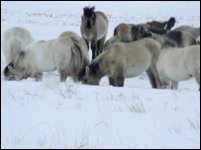♘امیرحسین♞
♘ مدیریت انجمن اسب ایران ♞
Genetic evidence is shedding new light on the origins of horses in the New World, during a particularly hazy period in their evolution.
As the Great Ice Age came to an end, some 11,000 years ago, North America was thought to be home to as many as 50 species and subspecies of horse.
But studies of ancient DNA tell a rather different story, suggesting the horses belonged to just two species.
These are the stilt-legged horses, now extinct, and the caballines.
The caballines are thought to be the ancestors of today's domestic horse.
"It looks like, as far as we can tell from the DNA, there is only evidence of two species in North America," Dr Alan Cooper from the University of Adelaide, Australia, told the BBC News website.
"We think that, in fact, people have been looking at these fossils and over-interpreting signs of changes in shape and size," he added.
"Probably these animals are adapting to local environments and perhaps they are [anatomically] more [changeable] than the palaeontologists had perhaps thought."
Mitochondrial clock
The work has implications for understanding other animals because horses are a textbook example of using fossil evidence to explain evolution.
Although the horse fossil record is very rich, our picture of when and where different species arose is clouded.
Analysis of mitochondrial DNA from fossilised bones, only possible in recent years, gives scientists a new tool to study evolution.
In research published in the open access journal Plos Biology, Dr Cooper and colleagues at Oxford University, UK, analysed mitochondrial DNA from fossilised horse bones.
Mitochondria, the powerpacks of the cell, have their own DNA and are inherited along the maternal line. Their DNA mutates at a stable rate, allowing researchers to look back in time at when different species diverged.
Land bridge
The Oxford research suggests that the stilt-legged horse, which was thought to have migrated into North America from Asia, at a time when the continents were linked by a land bridge, appears, in fact, to be native to North America.
And the Patagonian Hippidion horse found in South America appears to be much younger than previously thought.
It probably moved into South America about three million years ago, when the gap between North and South America closed up.
This was a seminal period of evolution, when animals from the two continents were able to mix after a long period of isolation.
As the Great Ice Age came to an end, some 11,000 years ago, North America was thought to be home to as many as 50 species and subspecies of horse.
But studies of ancient DNA tell a rather different story, suggesting the horses belonged to just two species.
These are the stilt-legged horses, now extinct, and the caballines.
The caballines are thought to be the ancestors of today's domestic horse.
"It looks like, as far as we can tell from the DNA, there is only evidence of two species in North America," Dr Alan Cooper from the University of Adelaide, Australia, told the BBC News website.
"We think that, in fact, people have been looking at these fossils and over-interpreting signs of changes in shape and size," he added.
"Probably these animals are adapting to local environments and perhaps they are [anatomically] more [changeable] than the palaeontologists had perhaps thought."
Mitochondrial clock
The work has implications for understanding other animals because horses are a textbook example of using fossil evidence to explain evolution.
Although the horse fossil record is very rich, our picture of when and where different species arose is clouded.
Analysis of mitochondrial DNA from fossilised bones, only possible in recent years, gives scientists a new tool to study evolution.
In research published in the open access journal Plos Biology, Dr Cooper and colleagues at Oxford University, UK, analysed mitochondrial DNA from fossilised horse bones.
Mitochondria, the powerpacks of the cell, have their own DNA and are inherited along the maternal line. Their DNA mutates at a stable rate, allowing researchers to look back in time at when different species diverged.
Land bridge
The Oxford research suggests that the stilt-legged horse, which was thought to have migrated into North America from Asia, at a time when the continents were linked by a land bridge, appears, in fact, to be native to North America.
And the Patagonian Hippidion horse found in South America appears to be much younger than previously thought.
It probably moved into South America about three million years ago, when the gap between North and South America closed up.
This was a seminal period of evolution, when animals from the two continents were able to mix after a long period of isolation.

